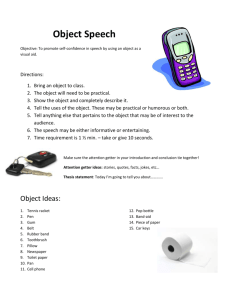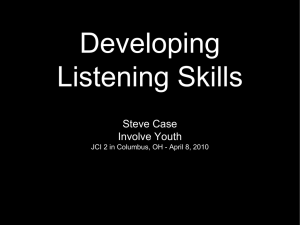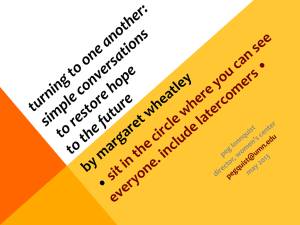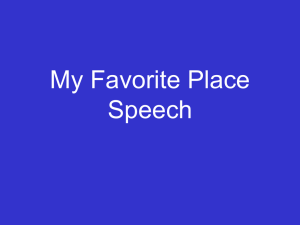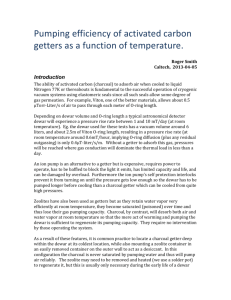Vocab for Final Dec_2014
advertisement
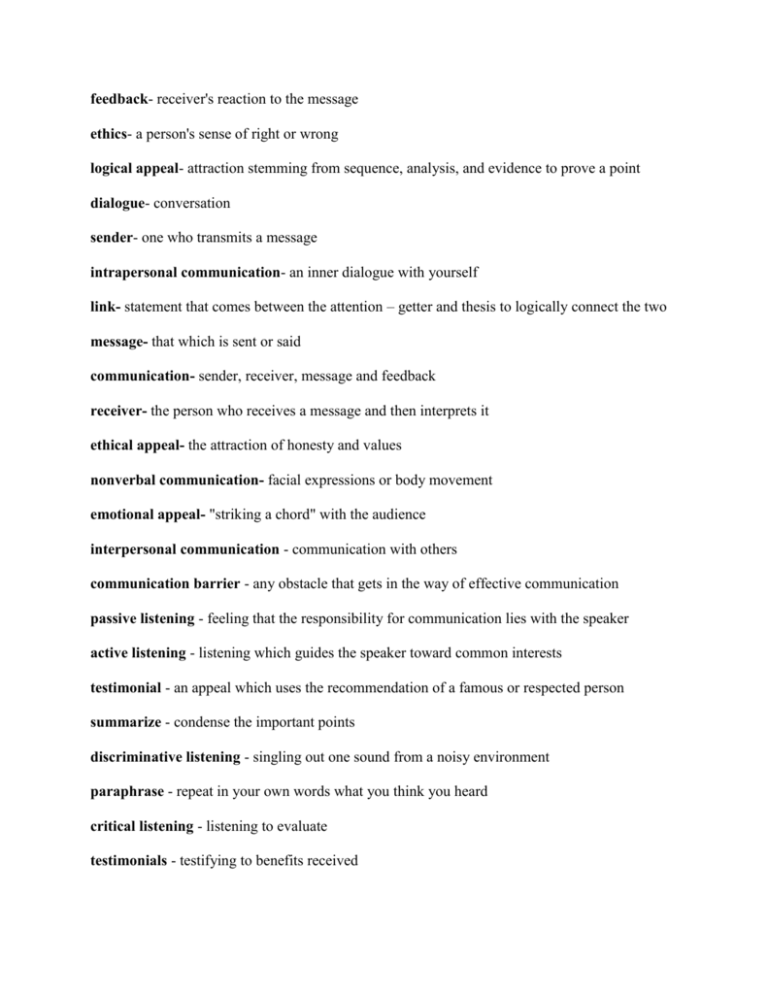
feedback- receiver's reaction to the message ethics- a person's sense of right or wrong logical appeal- attraction stemming from sequence, analysis, and evidence to prove a point dialogue- conversation sender- one who transmits a message intrapersonal communication- an inner dialogue with yourself link- statement that comes between the attention – getter and thesis to logically connect the two message- that which is sent or said communication- sender, receiver, message and feedback receiver- the person who receives a message and then interprets it ethical appeal- the attraction of honesty and values nonverbal communication- facial expressions or body movement emotional appeal- "striking a chord" with the audience interpersonal communication - communication with others communication barrier - any obstacle that gets in the way of effective communication passive listening - feeling that the responsibility for communication lies with the speaker active listening - listening which guides the speaker toward common interests testimonial - an appeal which uses the recommendation of a famous or respected person summarize - condense the important points discriminative listening - singling out one sound from a noisy environment paraphrase - repeat in your own words what you think you heard critical listening - listening to evaluate testimonials - testifying to benefits received nonverbal message - facial expressions or body movements used to express attitudes or moods about a person, situation or idea body language - the way one uses his or her body to send messages. tone of voice - the pitch and timbre (distinctive tone) of a person's voice. gesture - the use of hands, limbs, or the body to send a message. personal space - a comfort zone each person maintains around himself or herself where intrusions would be unwelcome. eye contact - a device speakers use whereby they look directly into their listeners eyes in order to emphasize a point or show how strongly they feel about something. discussion - a cooperative exchange of information, opinions, and ideas forum - often follows a panel discussion where audience members are allowed to ask questions to the presenters town hall meeting - people assemble in a large room to discuss their problems. They usually take a vote. brainstorming - bombarding a problem with fresh ideas consensus - occurs when the group reaches nearly unanimous agreement. tone - your mood or attitude dialogue - conversation outline - the speakers map problem-solution pattern - organization which presents a problem that provides ideas for solutions. purpose statement - the heart of the speech main headings - the major divisions, areas, or arguments of your purpose statement body - the first part of a three part speech quotation - an attention getter which uses someone’s exact words supporting material - intensifies and reinforces the main headings preview statement- sentence at the end of the intro that gives an overview of the major areas to be discussed in the speeches body introduction - first part of the outline establishing the central idea of the speech thesis statement- sentence that will tell you audience exactly what you will be speaking about narrative – an attention getter which tells a story bandwagon- most people have this or are doing this so you should as well or you will be left out. loaded words- only presenting information that is positive and omitting information that disagrees, uses words that have strong emotions testimonial- using an expert or celebrity to sell or support a product or ideal name calling- attempts to arouse prejudice among the public by labeling the target something that the public dislikes glittering generalities- using language associated with values and beliefs deeply held by the audience without providing supporting information or reason plain folk- Using ordinary people or trying to sound ordinary to sell something or persuade you to vote or support an idea transfer- an attempt to make the subject view a certain item in the same way as they view another item, to link the two in the subjects mind Day #5 gesture - the use of hands, limbs, or the body to send a message. personal space - a comfort zone each person maintains around himself or herself where intrusions would be unwelcome. intimate distance - the distance used primarily for confidential exchanges (within 18 inches) almost always reserved for close friends. personal distance - the distance comfortable for conversation between friends ( a foot and a half to four feet) social distance - the distance generally maintained between people in most social and business exchanges (4 to 12 feet) public distance - the distance maintained between strangers, at this distance people barely acknowledge each other’s presence (12 feet and beyond). Day #6 eye contact - a device speakers use whereby they look directly into their listeners eyes in order to emphasize a point or show how strongly they feel about something. discussion - a cooperative exchange of information, opinions, and ideas panel - 3-8 members sit facing the audience talking directly to each other about a problem or topic; example: talk show symposium - a formal discussion during which invited experts deliver short speeches on a subject while standing and facing an audience. forum - often follows a panel discussion where audience members are allowed to ask questions to the presenters town hall meeting - people assemble in a large room to discuss their problems. They usually take a vote. brainstorming - bombarding a problem with fresh ideas round table - a panel in which a small group talks about a topic of concern while sitting around a table or open circle. consensus occurs when the group reaches nearly unanimous agreement. tone - your mood or attitude dialogue - conversation networking - a variety of personal contacts to use for information. resume - a brief business document that highlights your accomplishments and skills interview - a business conversation to determine whether a candidate is right for a job mock interview - when you pretend to have one of these business conversations for practice portfolio - a sample of your work bridge - the transition from a question to a point that you wish to make sound bite - a short clipping from a radio or television interview. subordination -ranking and indenting items in an outline outline - the speakers map problem-solution pattern - organization which presents a problem that provides ideas for solutions. purpose statement - the heart of the speech cause-effect pattern - organization showing how one area leads to another main headings - the major divisions, areas, or arguments of your purpose statement body - the first part of a three part speech quotation - an attention getter which uses someone’s exact words supporting material - intensifies and reinforces the main headings preview statement- sentence at the end of the intro that gives an overview of the major areas to be discussed in the speeches body introduction - first part of the outline establishing the central idea of the speech spatial pattern - organization on the bases of space relationships commencement Address - graduation speech commemorative Speech - inspiring address that recalls heroic people or events eulogy - a speech to honor someone who has died climatic pattern – speech organization by order of importance chronological pattern-speech organization by time sequence transition- words and phrases that signal where the discussion is going thesis statement- sentence that will tell you audience exactly what you will be speaking about narrative – an attention getter which tells a story
